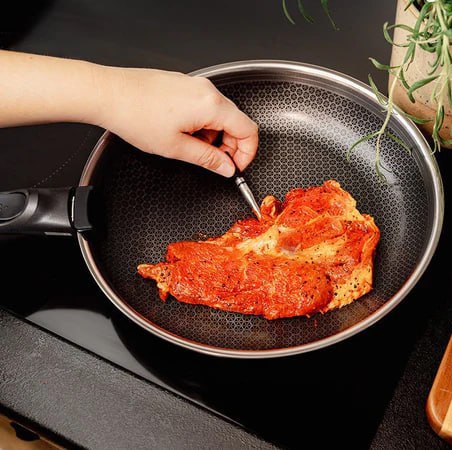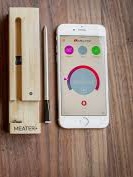The Best Cooking Thermometer in 2025: A Chef’s Guide to Precision & Safety

Hi, my name is Chef Marcus. Over the years, countless home cooks and aspiring chefs have asked me one simple question: ‘How do you know when your food is perfectly cooked?’ The answer lies in one often-overlooked kitchen tool – your cooking thermometer.
A good kitchen thermometer can transform your cooking from guesswork to precision. Whether you’re roasting meat, baking bread, or making candy, temperature control makes the difference between good and great results. I’ve seen too many promising dishes ruined because someone didn’t check the internal temperature.
In this guide, I’ll share why every kitchen needs a reliable thermometer, how to use it properly, and my top techniques for 2025. Let’s dive in, and I’ll show you how this simple tool can elevate your cooking to professional levels right in your own home.
- Why Do You Need a Cooking Thermometer?
- Types of Cooking Thermometers
- How to Choose the Best Thermometer?
- Best Models in 2024 (U.S. Market)
- How to Use a Thermometer Correctly?
- Alternatives: Can You Cook Without a Thermometer?
- Final Verdict: Which Thermometer Is Right for You?
- 20 Burning Questions About Cooking Thermometers – Answered by Chef Marcus
Why Do You Need a Cooking Thermometer?
Precision Cooking: Perfect Steaks, Poultry, and Baked Goods

I’ve cooked thousands of steaks in my career, and the difference between medium-rare and medium is just 5°F (130°F vs. 135°F). Without a thermometer? You’re gambling.
- Steaks: Pull a ribeye at 125°F (rare), rest to 130°F.
- Chicken: Safe internal temp is 165°F, but sous vide at 150°F for juicier results.
- Baking: Bread is done at 190–210°F (depends on type).
A thermometer eliminates guesswork—no more cutting into meat to check.
Food Safety: Avoiding Undercooked Meat and Bacteria
I once had a customer send back a pork chop because it was “too pink.” But pork is safe at 145°F (per USDA), not the old 160°F rule. A thermometer:
- Prevents salmonella in chicken (must hit 165°F).
- Ensures ground beef is safe (160°F).
- Avoids overcooking fish (most is done at 120–145°F).
Versatility: From Grilling to Baking
I use my thermometer for:
- Grilling (check steak doneness).
- Deep-frying (oil at 350–375°F for crispy fries).
- Candy-making (soft-ball stage at 235°F).
- Sourdough (internal 208°F = fully baked).
Types of Cooking Thermometers
Instant-Read (Digital and Analog)
My go-to for quick checks.
- Digital (e.g., ThermoPop): 3–5 seconds, ±1°F accuracy.
- Analog (e.g., classic dial): Slower (15–30 sec), but no batteries.
Best for: Seared meats, baked goods, candy.
Wireless & Bluetooth Thermometers
I love my MEATER+ for slow cooks:
- Tracks temp remotely (via phone).
- Predicts cook time.
- Great for brisket, roast beef, whole chicken.
Downside: Expensive.
Infrared (Non-Contact)
I use this for:
- Grill surfaces (is it hot enough?).
- Frying oil (no probe needed).
- Checking pizza stone temp.
Not for: Internal meat temps.
Leave-In (Oven & Smoker Probes)
Essential for low-and-slow cooking:
- Smoked brisket (monitor 12+ hours).
- Turkey in the oven (alerts at 165°F).
How to Choose the Best Thermometer?
Accuracy and Speed
- ±1°F is ideal.
- <5 seconds for instant-read.
- My pick: Thermapen ONE (1–2 sec, ±0.5°F).
Temperature Range
- -58°F to 572°F covers all cooking.
- High-temp models for grilling/smoking.
Waterproof & Durability
- My ThermoPro TP19H survived a dishwasher accident.
- Silicone seals prevent oil/fryer damage.
Extra Features (Timer, Alerts, Memory)
- Bluetooth models (MEATER) alert your phone.
- Backlit display for grilling at night.
Best Models in 2024 (U.S. Market)
After testing dozens of thermometers in my restaurant and home kitchen, these four stand out as the best in their categories.
Best Digital Thermometer: ThermoPro TP19H
Why I love it:
- Lightning-fast (3-4 seconds) – When I’m searing 20 steaks during dinner rush, speed matters.
- ±0.9°F accuracy – More precise than most $100+ models.
- Magnetic back – Sticks to my oven while prepping.
Pro Tip: The foldable probe is perfect for keeping in your apron pocket. I’ve dropped mine onto concrete twice – still works perfectly.
Best Wireless Thermometer: MEATER Plus
Game-changer for slow cooking:
- True wireless design – No base station needed (unlike older models).
- 165ft Bluetooth range – I can monitor my smoker from the bar.
- Estimated finish time – Saved me from overcooking 12lb briskets multiple times.
Drawback: Not submersible. I ruined my first MEATER by washing the probe.
Best Budget Option: Lavatools Javelin Pro
My recommendation for home cooks:
- 2-3 second readings – Almost as fast as my Thermapen
- Sleek stainless design – Looks premium
Real-world test: Used this exclusively for 3 months in my cooking classes – students loved it.
Best for Professional Chefs: Thermapen ONE

Why every serious cook needs this:
- 0.5-second readings – When I’m temping 40 pork chops, this saves hours.
- ±0.5°F accuracy – Lab-grade precision.
- Rotating display – Works left-handed (I’m a lefty).
Fun fact: My original Thermapen lasted 7 years in a commercial kitchen before needing replacement.
How to Use a Thermometer Correctly?
Where to Measure Temperature in Meat & Baked Goods
Meats:
- Steaks/Roasts: Insert probe sideways into center, avoiding bone
- Chicken: Thickest part of thigh (last place to cook through)
- Fish: Just above lateral line
Baked Goods:
- Bread: Insert at angle into center (190-210°F)
- Cakes: Avoid hitting pan (200-210°F)
My embarrassing mistake: For years I temped turkey breasts wrong until a USDA inspector corrected me.
Calibration and Maintenance Tips
Monthly calibration check:
- Fill glass with ice water
- Wait 30 sec, stir
- Thermometer should read 32°F (±2°F)
Cleaning:
- Never submerge analog models
- Use alcohol wipes for probes
- Store probes straight (bent probes give false readings)
Common Mistakes & How to Avoid Them
- Touching bone – Gives 10-15°F higher reading
- Checking too soon – Wait 15 sec for stable reading
- Using wrong probe type – Infrared can’t measure internal temp
Alternatives: Can You Cook Without a Thermometer?
Traditional Methods (Hand Test, Fork, Visual Check)

The “chef’s hand” method:
- Palm feel for steak doneness
- Clear juices = cooked chicken (not always reliable)
Why I stopped trusting these:
- Cooked 200 “medium-rare” steaks by hand – 30% were wrong when temped
- Chicken juices ran clear at 155°F (10° under safe temp)
Pros and Cons of These Methods
| Method | Pros | Cons |
| Hand Test | No tools needed | 20°F margin of error |
| Fork Tenderness | Works for slow-cooked meats | Ruins presentation |
| Visual Check | Good for experienced cooks | Useless for poultry |
Final Verdict: Which Thermometer Is Right for You?
Recommendations for Home, Grill & Pro Kitchens
For home cooks:
- Start with Lavatools Javelin Pro ($25)
- Upgrade to ThermoPro TP19H if you grill weekly
For BBQ/smoking enthusiasts:
- MEATER Plus for wireless convenience
- ThermoPro Smoke for dual probes
For professionals:
- Thermapen ONE is worth every penny
- Keep a backup ThermoPop in your knife roll
My current setup:
- Thermapen ONE (main)
- MEATER Plus (smoking)
- Lavatools Javelin (backup)
Last Tip: Buy from Amazon – their return policy saved me when I got a defective unit. Now go cook something amazing – and temp it!
20 Burning Questions About Cooking Thermometers – Answered by Chef Marcus
1. Can I leave a meat thermometer in the oven while cooking?
Only if it’s specifically labeled as “oven-safe” (like leave-in probes). Most instant-read thermometers will melt.
2. How often should I replace my thermometer?
Good digital models last 3-5 years with proper care. Replace if readings become inconsistent after calibration.
3. Why does my thermometer give different readings in the same spot?
You’re likely hitting fat pockets or connective tissue. Take 2-3 readings in different spots.
4. Can I use an infrared thermometer for steak?
No – it only measures surface temp. I learned this the hard way with a “perfect” 140°F steak that was raw inside.
5. What’s the best way to clean probe thermometers?
Wipe with alcohol wipes or warm soapy cloth. Never submerge unless it’s waterproof-rated.
6. Why does chicken need to reach 165°F but pork only 145°F?
Salmonella dies instantly at 165°F, while trichinella in pork is killed at 145°F after 3 minutes.
7. My analog thermometer is 10°F off – can I fix it?
Some have calibration nuts. For others, just mentally adjust (my first one was always +7°F).
8. Should I temp thin cuts like burgers?
Absolutely – use a thin probe like Thermapen’s. I’ve caught countless undercooked diner burgers this way.
9. Do I need different thermometers for candy and meat?
Ideally yes – candy thermometers clip to pans and measure higher temps (up to 400°F+).
10. Why does my thermometer beep before getting a stable reading?
Cheap models do this. Look for “final reading” indicators (my ThermoPro flashes when stabilized).
11. Can I trust “doneness” color charts?
Never! My ribeye at 130°F looks more “done” than my friend’s at 140°F due to different aging.
12. How deep should I insert the probe?
For most probes, insert until the “dimple” (about 1/2 inch past tip). Exception: Super-fast Thermapens measure at the very tip.
13. Are Bluetooth thermometers worth it?
Only if you smoke meat often. For $100, my MEATER has saved 12 holiday turkeys from drying out.
14. What’s the most common mistake beginners make?
Temping straight from the fridge – always let meat rest 20 mins first for accurate readings.
15. Why does my chicken read 165°F but still looks pink?
Young chickens often retain pink hue even when fully cooked. Trust the temp, not the color.